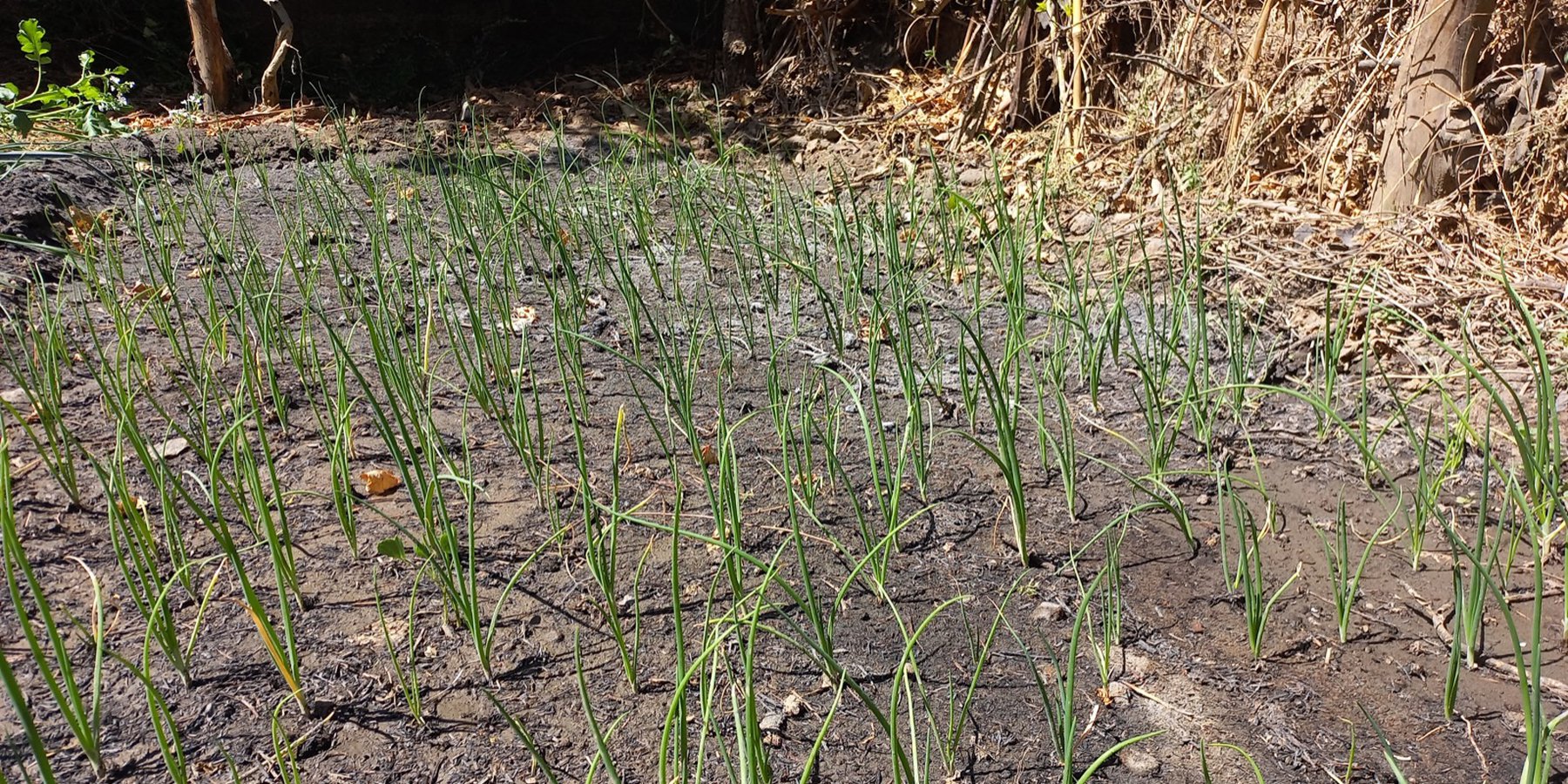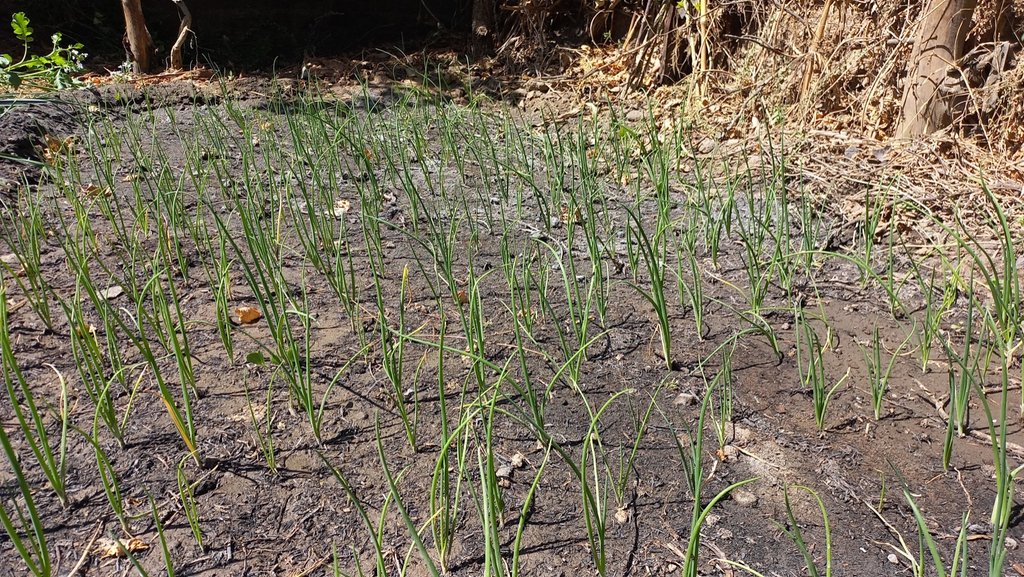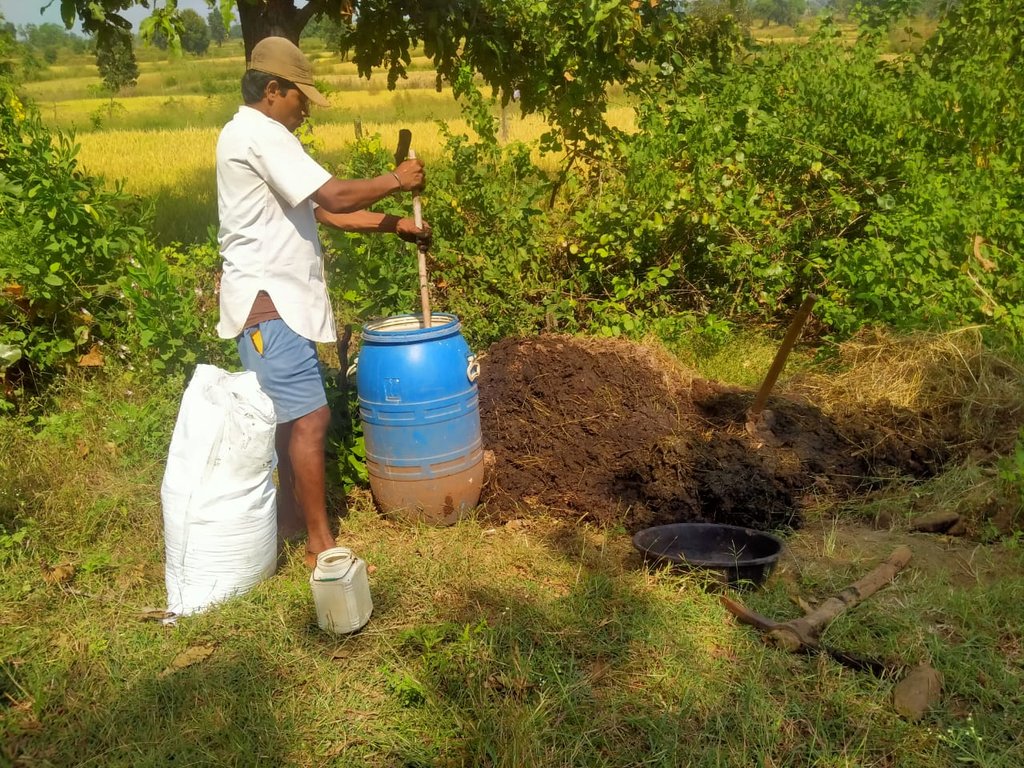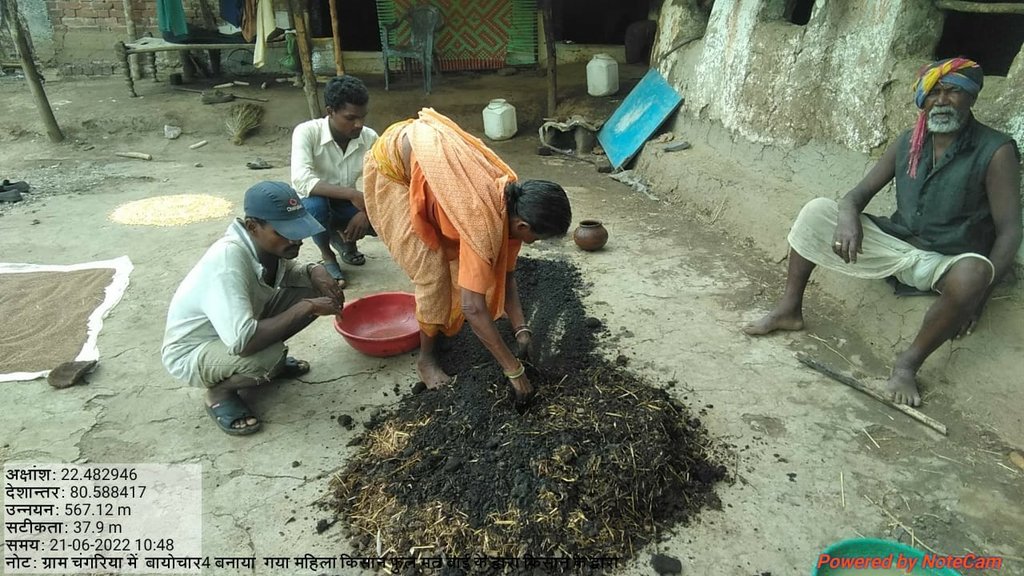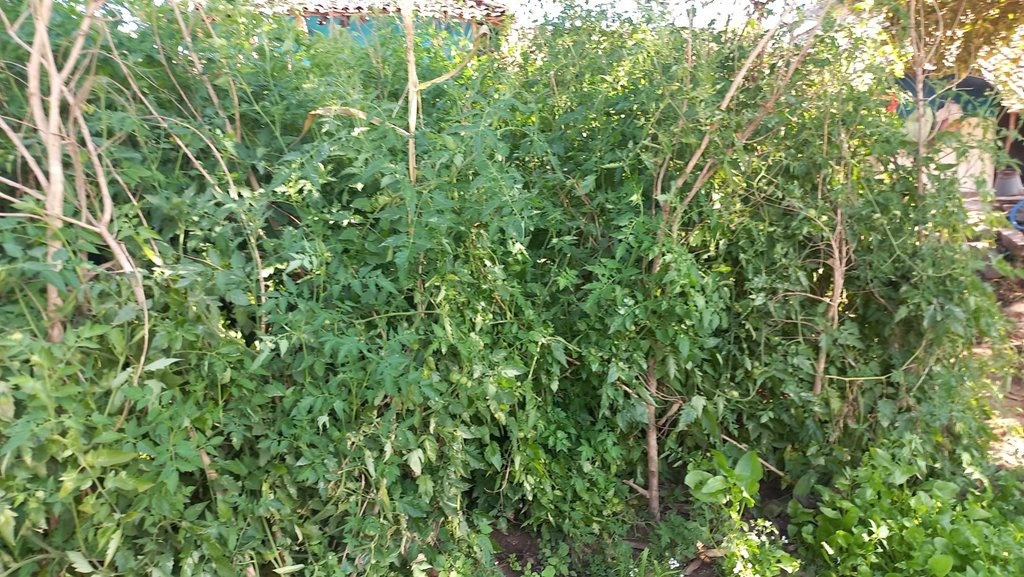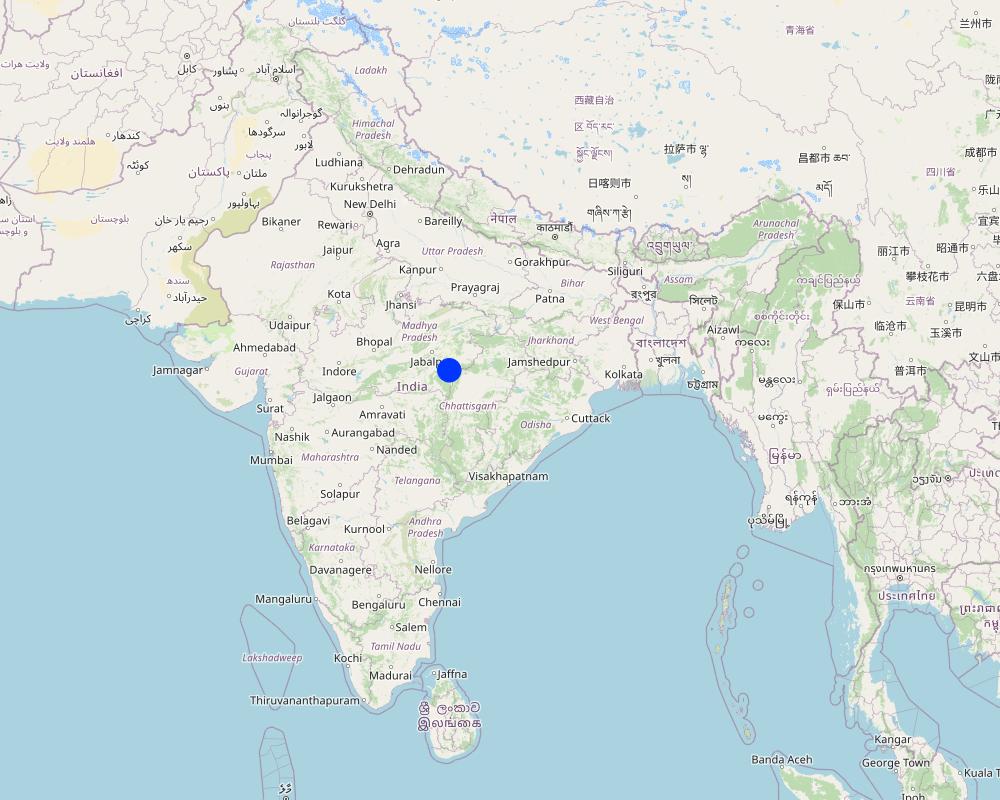Biochar Application on Homestead Land [India]
- Creation:
- Update:
- Compiler: Santosh Gupta
- Editors: Noel Templer, Stephanie Katsir, Kim Arora, Tabitha Nekesa, Ahmadou Gaye, Siagbé Golli
- Reviewers: Udo Höggel, Sally Bunning
technologies_6693 - India
View sections
Expand all Collapse all1. General information
1.2 Contact details of resource persons and institutions involved in the assessment and documentation of the Technology
Name of project which facilitated the documentation/ evaluation of the Technology (if relevant)
Soil protection and rehabilitation for food security (ProSo(i)l)Name of the institution(s) which facilitated the documentation/ evaluation of the Technology (if relevant)
GIZ India (GIZ India) - IndiaName of the institution(s) which facilitated the documentation/ evaluation of the Technology (if relevant)
Alliance Bioversity and International Center for Tropical Agriculture (Alliance Bioversity-CIAT) - KenyaName of the institution(s) which facilitated the documentation/ evaluation of the Technology (if relevant)
Ecociate Consultants (Ecociate Consultants) - India1.3 Conditions regarding the use of data documented through WOCAT
The compiler and key resource person(s) accept the conditions regarding the use of data documented through WOCAT:
Yes
1.4 Declaration on sustainability of the described Technology
Is the Technology described here problematic with regard to land degradation, so that it cannot be declared a sustainable land management technology?
No
Comments:
The technology described here is the application of biochar on homestead land. This technology positively impacts soil health and crop production.
2. Description of the SLM Technology
2.1 Short description of the Technology
Definition of the Technology:
Biochar is a carbon-rich solid formed from the organic residue by pyrolysis. Biochar is a stable, highly water and nutrient-retentive product that benefits microorganisms and has a very high carbon sequestration potential. Farmers in the project area have applied it to their homesteads or kitchen gardens.
2.2 Detailed description of the Technology
Description:
Biochar, a sustainable soil amendment, is produced through pyrolysis, where organic matter such as wood or agricultural waste is heated in a closed container under low-oxygen conditions. Applying biochar to soil has numerous benefits for improving soil health, such as enhancing soil fertility, reducing greenhouse gas emissions, improving soil microbiology, and reducing soil erosion. One of the most significant benefits of biochar is its ability to sequester atmospheric carbon dioxide into the soil, which can help mitigate climate change by reducing the amount of carbon dioxide in the atmosphere. Biochar can also remove contaminants from soil and water and serve as a compost component.
Biochar also reduces the emission of ammonia and carbon dioxide (Cabeza et al. 2018), lowers soil compactness, optimizes compost (Liang et al. 2010), improves water retention and the sorption of heavy metals, increases the availability of micronutrients for plants and increases the pH of soils (Van Zwieten et al. 2010). Biochar also stimulates the growth of rhizosphere microorganisms and mycorrhizal fungi (Głuszek et al. 2017). These bacteria and fungi may also promote plant growth (Compant et al. 2010). The pH values of biochars are positively correlated with the formation of carbonates and the contents of inorganic alkalis (Ding et al. 2014). The pH value of biochar ranges from 6.5 to 10.8. It is advisable to test the pH values of both soils and biochar to reach at the optimal quantity of biochar to be applied in the field.
In the Mandla district, agriculture is the backbone of the economy, and farmers are constantly adopting new farming technologies to increase their agricultural production. One such technology that has positively impacted more than a thousand farmers in the region is the application of biochar in homestead land under a GIZ-funded Soil protection and rehabilitation of degraded soil for food security in India (ProSoil) program. Biochar in this region is prepared using low cost Biochar Kiln units developed by Indian council of agriculture research institutions, traditional methods, such as digging soil pits and burning organic residue while covering its top with soil. Since the Mandla district is a high-rainfall region, most farmers broadcast biochar over their fields before growing rabi (winter) crops. Commonly grown rabi crops in this region are mustard, vegetables, and maize.
Farmers in the Mandla district use small units of biochar production. The recovery rate of biochar is 20%, with a capacity of 100kg of organic material. The application rate per unit area varies from farmer to farmer.
1. Landholding: Farmers with more extensive land holdings or generally rotationally applied biochar in the parcels.
2. The intervention of biochar application was introduced in this region in 2020. The new practice is evolving, and the application rate of biochar varies from farmer to farmer depending on the availability of raw materials and labour availability (family/hired)
The most suitable biochar application rate is 10 − 20 t/ha. Moreover, it is essential to consider the compatibility and complementarity between biochar, soil texture, and management factors such as Nitrogen (N) application rate, pH values and growing environment into consideration (Yang Gao et al., 2021). More scientific studies are needed to define the quantity of biochar needed based on the local soil conditions. However, the current quantity of applications is very low compared to suggested in secondary documents.
The immediate effects of biochar application on crop production have been significant, with farmers reporting an increase in crop yield by 20-25% across most crops. Simple indicators such as increased grain weight and improved grain quality imply that the crop produced is of higher quality. Another critical benefit highlighted by farmers of biochar application is the retention of soil moisture over a longer duration compared to non-treated fields. Biochar can help the farmers of the Mandla district increase their agricultural productivity while promoting sustainable land use practices.
2.3 Photos of the Technology
General remarks regarding photos:
All the photos have been taken with the consent of participants
2.5 Country/ region/ locations where the Technology has been applied and which are covered by this assessment
Country:
India
Region/ State/ Province:
Madhya Pradesh
Further specification of location:
Mandla
Specify the spread of the Technology:
- applied at specific points/ concentrated on a small area
Is/are the technology site(s) located in a permanently protected area?
No
Comments:
Field visits in Gabri and Changariya villages of Bichhhiya block were conducted to understand the technology
Map
×2.6 Date of implementation
Indicate year of implementation:
2020
2.7 Introduction of the Technology
Specify how the Technology was introduced:
- during experiments/ research
- through projects/ external interventions
Comments (type of project, etc.):
The application of biochar for improving soil health and crop production was introduced in this region through the GIZ-funded program
3. Classification of the SLM Technology
3.1 Main purpose(s) of the Technology
- improve production
- reduce, prevent, restore land degradation
- conserve ecosystem
- mitigate climate change and its impacts
- create beneficial economic impact
3.2 Current land use type(s) where the Technology is applied
Land use mixed within the same land unit:
Yes
Specify mixed land use (crops/ grazing/ trees):
- Agroforestry

Cropland
- Annual cropping
Annual cropping - Specify crops:
- cereals - maize
- cereals - millet
- cereals - rice (wetland)
- cereals - sorghum
- legumes and pulses - lentils
- Mustard
Number of growing seasons per year:
- 2
Specify:
Mandla district is predominantly a rainfed region. Homestead land generally has some irrigation facilities available for Kharif (summer) and Rabi (winter) crops.
Is intercropping practiced?
No
Is crop rotation practiced?
Yes
If yes, specify:
Vegetable crops such as leafy vegetables, tomatoes, onions, tuber crops, mustard, and maize are commonly grown by farmers. The primary purpose of growing crops on homestead land is to fulfill household-level nutritional requirements.
Comments:
As per the district census handbook of Mandla District 2001, the land use pattern of Mandla District is: 61% - under forest area, 21% - cropped area, 5% - not available for cultivation, 7% - under fallow land, and 2% - cultivable area. The net area irrigated is 7% of the net area sown, which has hardly increased in recent times (~9%).
3.3 Has land use changed due to the implementation of the Technology?
Has land use changed due to the implementation of the Technology?
- No (Continue with question 3.4)
Comments:
There has been no change in land use pattern due to project interventions.
3.4 Water supply
Water supply for the land on which the Technology is applied:
- mixed rainfed-irrigated
Comments:
Mandla has nearly 9% of its net sown area irrigated. The homestead land, where biochar is applied during the rabi season, has some irrigation from surface- or groundwater sources.
3.5 SLM group to which the Technology belongs
- agroforestry
- improved ground/ vegetation cover
- integrated soil fertility management
3.6 SLM measures comprising the Technology

agronomic measures
- A1: Vegetation/ soil cover
- A2: Organic matter/ soil fertility

management measures
- M2: Change of management/ intensity level
Comments:
The application of biochar in the field has improved the water-holding capacity of the soil along with enhanced microbial activities. This has resulted in better and long-duration vegetation as farmers are in position to cultivate vegetables throughout the year.
3.7 Main types of land degradation addressed by the Technology

soil erosion by water
- Wt: loss of topsoil/ surface erosion

chemical soil deterioration
- Cp: soil pollution

physical soil deterioration
- Pc: compaction
- Pu: loss of bio-productive function due to other activities

biological degradation
- Bc: reduction of vegetation cover
- Bl: loss of soil life
Comments:
Biochar acts as soil amendment which helps in improving soil health and status of nutrients in the soil. Some studies have also suggested increase in soil organic carbon as a result of biochar application. Farmers in the project area were also advised to reduce the tillage practices to minimise the soil disturbance.
3.8 Prevention, reduction, or restoration of land degradation
Specify the goal of the Technology with regard to land degradation:
- prevent land degradation
- reduce land degradation
Comments:
Prior to the application of biochar, farmers were applying synthetic fertilisers and pesticide which was degrading the land. The replacement of synthetic fertilisers with Biochar (also FYM and cow urine mixed with it) has prevented further soil degradation.
4. Technical specifications, implementation activities, inputs, and costs
4.1 Technical drawing of the Technology
Technical specifications (related to technical drawing):
The drawing presented here is of a biochar kiln unit being developed by the Central Research Institute for Dryland Agriculture (CRIDA) in India for Biochar preparation. A similar unit was used by the land users in the project area. There were some farmers who also did some modifications to make it friendly for the local context. More details about this unit can be obtained from the following sources.
http://www.nicra-icar.in/nicrarevised/images/Books/Biochor%20Bulletin.pdf
http://icar-crida.res.in/Pubs/Biochar%20Research%20Bulletin%20March%202018.pdf (for a description of the HOW to make biochar)
Author:
Central Research Institute for Dryland Agriculture (CRIDA)
4.2 General information regarding the calculation of inputs and costs
Specify how costs and inputs were calculated:
- per Technology area
Indicate size and area unit:
1 Ha
other/ national currency (specify):
INR
If relevant, indicate exchange rate from USD to local currency (e.g. 1 USD = 79.9 Brazilian Real): 1 USD =:
82.5
Indicate average wage cost of hired labour per day:
204
4.3 Establishment activities
| Activity | Timing (season) | |
|---|---|---|
| 1. | Purchase of Biochar Kiln Unit | Once in 4-5 years |
Comments:
Since it's a seasonal activity there are not many activities which can be categorised here.
4.4 Costs and inputs needed for establishment
| Specify input | Unit | Quantity | Costs per Unit | Total costs per input | % of costs borne by land users | |
|---|---|---|---|---|---|---|
| Equipment | Biochar Kiln unit | Number | 1.0 | 9000.0 | 9000.0 | 10.0 |
| Equipment | Transportation | LS | 1.0 | 2000.0 | 2000.0 | 10.0 |
| Total costs for establishment of the Technology | 11000.0 | |||||
| Total costs for establishment of the Technology in USD | 133.33 | |||||
If land user bore less than 100% of costs, indicate who covered the remaining costs:
Project has financially supported the local environment committes in purchase and setting up of the Biochar Kiln units
Comments:
Biochar is prepared by a low-cost method:
1. Using Soil pit kiln - Human Labor cost is usually applied as no capital cost is involved in this method.
2. Using Portable Kiln - Its cost generally range from 12000 -14000 Rs if purchased from the ICAR institutions and their associated fabricators. Sometimes farmers also get it made from the local fabricators which cost Rs 4000-6000
Refer to the following Study: Biochar production from Lantana camara (invasive species);-
https://qcat.wocat.net/en/wocat/technologies/view/technologies_6690/
4.5 Maintenance/ recurrent activities
| Activity | Timing/ frequency | |
|---|---|---|
| 1. | Preparation of Biochar using the Lantana Camara | After the monsoon season (September) |
| 2. | Preparing the biochar for application by mixing it with cow dung and cow urine | During Rabi Season (Oct-Nov) |
| 3. | Application of Biochar in homestead land | During Rabi Season (Oct-Nov) |
Comments:
A low-cost method of biochar preparation (traditional soil pit or portable kiln method) is used for biochar preparation. Due to simplicity in design, barely any cost is involved in the maintenance of the unit.
4.6 Costs and inputs needed for maintenance/ recurrent activities (per year)
| Specify input | Unit | Quantity | Costs per Unit | Total costs per input | % of costs borne by land users | |
|---|---|---|---|---|---|---|
| Labour | Transportation of biomass and its drying before biochar production | Person-day | 2.0 | 200.0 | 400.0 | 100.0 |
| Labour | Preparation of Biochar by family members | Person-day | 2.0 | 200.0 | 400.0 | 100.0 |
| Labour | Mixing biochar with cow dung and cow urine and making it ready for the application | Person-day | 1.0 | 200.0 | 200.0 | 100.0 |
| Labour | Biochar Application | Person-day | 1.0 | 200.0 | 200.0 | 100.0 |
| Fertilizers and biocides | Biomass for Biochar production (Approximate) | 1.0 | 500.0 | 500.0 | 100.0 | |
| Fertilizers and biocides | Cow dung | kg | 20.0 | 5.0 | 100.0 | 100.0 |
| Fertilizers and biocides | Cow urine | kg | 20.0 | 5.0 | 100.0 | 100.0 |
| Total costs for maintenance of the Technology | 1900.0 | |||||
| Total costs for maintenance of the Technology in USD | 23.03 | |||||
Comments:
A majority of the cost mentioned here is an opportunity cost for the farmers as they do manage all these expenses internally with available family labour and input materials such as cow dung, cow urine biomass etc.
4.7 Most important factors affecting the costs
Describe the most determinate factors affecting the costs:
The primary factor affecting the cost is the labor cost for applying biochar to the field and the easy availability of biomass/crop residues/Lantana for biochar production
5. Natural and human environment
5.1 Climate
Annual rainfall
- < 250 mm
- 251-500 mm
- 501-750 mm
- 751-1,000 mm
- 1,001-1,500 mm
- 1,501-2,000 mm
- 2,001-3,000 mm
- 3,001-4,000 mm
- > 4,000 mm
Specify average annual rainfall (if known), in mm:
1427.70
Specifications/ comments on rainfall:
Monsoon season is June-September which has the majority of the rainfall
Indicate the name of the reference meteorological station considered:
District at glance report of Ministry of Water Resources, Central Groundwater Board, North Central Region BHOPAL, 2013
Agro-climatic zone
- sub-humid
- semi-arid
The National Bureau of Soil Survey & Land Use Planning (NBSS&LUP) developed twenty agroecological zones based on the growing period as an integrated criterion of adequate rainfall and soil groups. It delineated boundaries adjusted to district boundaries with a minimal number of regions. Mandla District of Madhya Pradesh lies in a hot sub-humid ecoregion with red and black soil. The length of the growing period varies from block to block based on the availability of irrigation with farmers. Thus both sub-humid and semi-arid agroclimatic zones are being considered for the District.
Precipitation: 1000–1500 mm; Potential Evapotranspiration: 1300–1500 mm; Length of Growing Period: 150–180 days
5.2 Topography
Slopes on average:
- flat (0-2%)
- gentle (3-5%)
- moderate (6-10%)
- rolling (11-15%)
- hilly (16-30%)
- steep (31-60%)
- very steep (>60%)
Landforms:
- plateau/plains
- ridges
- mountain slopes
- hill slopes
- footslopes
- valley floors
Altitudinal zone:
- 0-100 m a.s.l.
- 101-500 m a.s.l.
- 501-1,000 m a.s.l.
- 1,001-1,500 m a.s.l.
- 1,501-2,000 m a.s.l.
- 2,001-2,500 m a.s.l.
- 2,501-3,000 m a.s.l.
- 3,001-4,000 m a.s.l.
- > 4,000 m a.s.l.
Indicate if the Technology is specifically applied in:
- not relevant
Comments and further specifications on topography:
Mandla District is hilly and forested (Satpura hill range) and highly undulating with a narrow strip of cultivated plains in the valley portion of the river and rivulet. The plateau is in the northern part, formed by basalt and east-west trending hills in the southern part. The highest elevation is 934m ASL in the northern region, and the lowest elevation is around 400m ASL.
5.3 Soils
Soil depth on average:
- very shallow (0-20 cm)
- shallow (21-50 cm)
- moderately deep (51-80 cm)
- deep (81-120 cm)
- very deep (> 120 cm)
Soil texture (topsoil):
- coarse/ light (sandy)
- medium (loamy, silty)
Soil texture (> 20 cm below surface):
- medium (loamy, silty)
- fine/ heavy (clay)
Topsoil organic matter:
- low (<1%)
If available, attach full soil description or specify the available information, e.g. soil type, soil PH/ acidity, Cation Exchange Capacity, nitrogen, salinity etc.
The soils in the area are generally clayey loam types with sandy loam soil in some areas. In the northern and central parts of the District, the undulating plateau with mounds is covered with slightly deep soil. Regarding the classification of ‘Soils of the World,’ the soils of Mandla are characterized as ‘brown earth.’ These types of soils have developed from granite gneiss and quartzite schist complexes.
5.4 Water availability and quality
Ground water table:
5-50 m
Availability of surface water:
medium
Water quality (untreated):
poor drinking water (treatment required)
Water quality refers to:
both ground and surface water
Is water salinity a problem?
No
Is flooding of the area occurring?
No
Comments and further specifications on water quality and quantity:
The pre-monsoon groundwater level in the area ranges from 3 to 14 meters below ground level. (District at Glance, Mandla, Central Ground Water Board, 2013). The locations have a river flowing close to the area; however, access to the surface and sub-surface water is a primary concern. Basaltic lava flows of the Deccan trap underlie the Mandla District. All blocks of the district including project block Bichhiya are categorized as safe blocks. The net groundwater availability in the district is 53779 hectare meters (ham), and the groundwater draft for all uses is 8205 ham, making the Stage of Groundwater Development 15% as a whole for the district. The area's topography, soil, and geology do not let water remain for long durations, causing water scarcity in summer. The irrigation facilities are poor and limited to areas adjoining dams and canals.
5.5 Biodiversity
Species diversity:
- high
Habitat diversity:
- high
Comments and further specifications on biodiversity:
The area is surrounded by the Kanha National Park and Phen Wildlife Sanctuary, with a good presence of forest area. Thus biodiversity is outstanding. Ecological assessment report in Mandla (where this Technology is applied) showed improved biodiversity on common lands under village governance compared to open-access or commons under government ownership. On average, the Shannon diversity index (https://www.statology.org/shannon-diversity-index/) of managed common lands was 1.45 compared to 0.42 for the open access or ungoverned commons. Most of the sites under open access lands are infested by Lantana camara, which is the main reason for the lower biomass and diversity of the ungoverned grounds. More information about the biodiversity in Mandla can be read through the following link.
https://mpsbb.mp.gov.in/completedProject/MB.pdf
5.6 Characteristics of land users applying the Technology
Sedentary or nomadic:
- Sedentary
Market orientation of production system:
- mixed (subsistence/ commercial)
Off-farm income:
- > 50% of all income
Relative level of wealth:
- poor
- average
Individuals or groups:
- individual/ household
Level of mechanization:
- manual work
- animal traction
Gender:
- women
- men
Age of land users:
- youth
- middle-aged
Indicate other relevant characteristics of the land users:
A large majority of the user belonging to the tribal community, including some households from an ethnic community called Baiga.
5.7 Average area of land used by land users applying the Technology
- < 0.5 ha
- 0.5-1 ha
- 1-2 ha
- 2-5 ha
- 5-15 ha
- 15-50 ha
- 50-100 ha
- 100-500 ha
- 500-1,000 ha
- 1,000-10,000 ha
- > 10,000 ha
Is this considered small-, medium- or large-scale (referring to local context)?
- small-scale
Comments:
Around 2000 farmers in different crops have applied the technology
5.8 Land ownership, land use rights, and water use rights
Land ownership:
- communal/ village
- individual, titled
Land use rights:
- individual
Water use rights:
- communal (organized)
- individual
Are land use rights based on a traditional legal system?
Yes
Specify:
The concerned authorities have issued landowners the land certificates.
5.9 Access to services and infrastructure
health:
- poor
- moderate
- good
education:
- poor
- moderate
- good
technical assistance:
- poor
- moderate
- good
employment (e.g. off-farm):
- poor
- moderate
- good
markets:
- poor
- moderate
- good
energy:
- poor
- moderate
- good
roads and transport:
- poor
- moderate
- good
drinking water and sanitation:
- poor
- moderate
- good
financial services:
- poor
- moderate
- good
Advisory and extension (limited to only project teams):
- poor
- moderate
- good
Comments:
Over the years, there has been a development focus from both the Government and other civil society organizations to bring out the facilities at the door of communities, which has improved access of different facilities.
6. Impacts and concluding statements
6.1 On-site impacts the Technology has shown
Socio-economic impacts
Production
crop production
Comments/ specify:
There has not been any systematic impact assessment study to quantify the impact of the intervention. However, in discussions with farmers and implementing agencies during the field visit, an increase of 20-25% in the production of farm products was reported.
crop quality
Comments/ specify:
Change in crop weight and colour is observed by farmers
land management
Comments/ specify:
Improved Soil Health is indicated by farmers based on their observation of improved soil structure, water-holding capacity and soil texture
Income and costs
farm income
Comments/ specify:
On the account of improved productivity, farmers have reported an increase in their income. However, there has not been any systematic study on the same.
Socio-cultural impacts
SLM/ land degradation knowledge
Comments/ specify:
The preparation of biochar from invasive species and its application to soil improved the understanding of farmers on the negative impact of invasive species and advantages of biochar application
Ecological impacts
Soil
soil moisture
Comments/ specify:
Soil structure improved by biochar application, improving water holding capacity of soil
soil loss
Comments/ specify:
Reduction in soil erosion due to improvement in soil structure
soil compaction
Comments/ specify:
Reduction in soil compaction due to improvement in soil structure
soil organic matter/ below ground C
Comments/ specify:
Based on the observation of farmers and implementing agency, random soil tests of farmers have indicated a slight increase in soil organic carbon
Biodiversity: vegetation, animals
invasive alien species
Comments/ specify:
Reduction in invasive alien species named lantana cantara which was uprooted for preparing biochar
Climate and disaster risk reduction
micro-climate
Comments/ specify:
Improve soil health create an enabling environment for soil micro-organism
Specify assessment of on-site impacts (measurements):
All the indicated impact measures are based on discussions with farmers, implementing agencies and other stakeholders. These were reported as per their observations, eye estimations and approximation.
6.2 Off-site impacts the Technology has shown
Biochar is prepared using invasive species of Lantana Camara. Its eradication from private and commercial land improves the ecosystem.
Specify assessment of off-site impacts (measurements):
The scale of implementation is not large enough to have an ecosystem level impact
6.3 Exposure and sensitivity of the Technology to gradual climate change and climate-related extremes/ disasters (as perceived by land users)
Gradual climate change
Gradual climate change
| Season | increase or decrease | How does the Technology cope with it? | |
|---|---|---|---|
| other gradual climate change | When biochar is added to soil, it can sequester carbon in the form of stable organic matter, which can remain in the soil for hundreds or even thousands of years. This carbon sequestration can help to reduce the amount of carbon dioxide in the atmosphere, thereby mitigating climate change. | decrease | well |
6.4 Cost-benefit analysis
How do the benefits compare with the establishment costs (from land users’ perspective)?
Short-term returns:
positive
Long-term returns:
very positive
How do the benefits compare with the maintenance/ recurrent costs (from land users' perspective)?
Short-term returns:
positive
Long-term returns:
very positive
Comments:
The benefits as indicated above are much higher than the cost involved. More importantly cost is too less as all the resources are being managed internally by the farmers.
6.5 Adoption of the Technology
- 1-10%
If available, quantify (no. of households and/ or area covered):
More than 3000 farmers
6.7 Strengths/ advantages/ opportunities of the Technology
| Strengths/ advantages/ opportunities in the land user’s view |
|---|
| Increase crop production |
| Improve the quality of farm produce |
| Improve soil water holding capacity |
| Strengths/ advantages/ opportunities in the compiler’s or other key resource person’s view |
|---|
| Improved soil health |
| Mitigate climate change |
| Increase in soil nutrient content |
| Reduction in cost of inputs |
6.8 Weaknesses/ disadvantages/ risks of the Technology and ways of overcoming them
| Weaknesses/ disadvantages/ risks in the land user’s view | How can they be overcome? |
|---|---|
| Manual labor is required for the preparation of biochar | Innovating/adopting automation in biochar preparation |
| Decentralized preparation of biochar | Developing enterprise for selling cost-effective biochar in a localized manner |
| Weaknesses/ disadvantages/ risks in the compiler’s or other key resource person’s view | How can they be overcome? |
|---|---|
| Limited understanding of standardization of biochar quality and rate of application | Conducting more research studies and documenting experiences of farmers |
7. References and links
7.1 Methods/ sources of information
- field visits, field surveys
1
- interviews with land users
8
- interviews with SLM specialists/ experts
1
- compilation from reports and other existing documentation
3
When were the data compiled (in the field)?
22/02/2023
Comments:
During the field visit, detailed discussions were held with the project implementing agency, communities, and other stakeholders to understand the process and impact of the intervention
7.2 References to available publications
Title, author, year, ISBN:
Significance of biochar application to the environment and economy, Babalola Aisosa Onia,⁎, Olubukola Oziegbeb, Obembe O. Olawole
Available from where? Costs?
https://doi.org/10.1016/j.aoas.2019.12.006
Title, author, year, ISBN:
Impacts of biochar application on upland agriculture: A review, Kumuduni Niroshika Palansooriyaa,1, Yong Sik Oka,1, Yasser Mahmoud Awada, Sang Soo Leeb, Jwa-Kyung Sungc, Agamemnon Koutsospyrosd, Deok Hyun Moone
Available from where? Costs?
https://doi.org/10.1016/j.jenvman.2018.12.085
Title, author, year, ISBN:
The role of biochar and biochar-compost in improving soil quality and crop performance: A review, Getachew Agegnehua,⁎, A.K. Srivastavab, Michael I. Birda
Available from where? Costs?
http://dx.doi.org/10.1016/j.apsoil.2017.06.008
Title, author, year, ISBN:
Biochar physicochemical properties: pyrolysis temperature and feedstock kind effects
Available from where? Costs?
https://link.springer.com/article/10.1007/s11157-020-09523-3
7.3 Links to relevant online information
Title/ description:
District at glance - Mandla
URL:
http://cgwb.gov.in/District_Profile/MP/Mandla.pdf
Title/ description:
District Census Handbook Mandla
URL:
http://lsi.gov.in:8081/jspui/bitstream/123456789/2097/1/38136_2001_MAN.pdf
Links and modules
Expand all Collapse allLinks
No links
Modules
No modules


